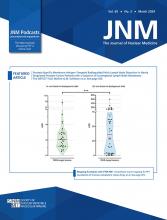Medullary thyroid cancer (MTC), a neuroendocrine tumor arising from the parafollicular cells of the thyroid gland, accounts for approximately 1%–2% of all thyroid cancers (1). Only recently was cholecystokinin-2 receptor (CCK2R) identified as a suitable target for PET/CT imaging of MTC (2,3).
We report on a 74-y-old man with a history of locally advanced MTC who had undergone tumor debulking including a hemithyroidectomy and lymph node dissection on the right side. Informed consent was obtained from the patient, and the project was approved by the institutional ethics committee of Ludwig-Maximilians-Universität München, Munich, Germany (permit 23-0627).
Postoperative [18F]F-3,4-dihydroxyphenylalanine (DOPA) PET/CT detected residual local tumor as well as cervical and upper mediastinal lymph node metastases, prompting additional external-beam radiotherapy. After treatment, serum calcitonin levels decreased (from 5,300 to 720 pg/mL) but remained significantly elevated. Thus, another restaging with [18F]F-DOPA PET/CT (201 MBq) was performed.
To assess the possibility of CCK2R-directed radioligand therapy, the patient additionally underwent PET/CT with [68Ga]Ga-DOTA-CCK-66 (150 MBq; time interval between scans, 16 d), a novel CCK2R-directed tracer. It was well tolerated and demonstrated a favorable biodistribution with only physiologic uptake in the stomach and renal tracer excretion. In concordance with [18F]F-DOPA, [68Ga]Ga-DOTA-CCK-66 detected an identical number of MTC lesions composing the still viable local tumor (SUVmax of 7.4, vs. 7.0 for [18F]F-DOPA), as well as multiple cervical and mediastinal lymph node metastases (SUVmax of 9.5, vs. 8.7 for [18F]F-DOPA) (Fig. 1).
Maximum-intensity projections and axial sections of [68Ga]Ga-DOTA-CCK-66 (A) and [18F]F-DOPA (B) PET/CT. White stars indicate local tumor in left thyroid bed. Arrows indicate lymph node metastasis in right upper mediastinum. Intensity scale bars are SUV.
CCK2R-directed PET imaging with [68Ga]Ga-DOTA-CCK-66 is feasible. Given the possibility of receptor-directed radioligand therapy using its 177Lu- or 225Ac-labeled analog, this new compound might prove a valuable addition to the theranostic armamentarium in MTC. Further research with a special focus on kidney doses, which have been a relevant issue for therapeutic CCK2R ligands regarding the amount of administered activity, is warranted.
DISCLOSURE
A patent application on CCK2R-targeted compounds was filed by Thomas Günther, Nadine Holzleitner, Hans-Jürgen Wester, and Constantin Lapa. No other potential conflict of interest relevant to this article was reported.
Footnotes
Published online Nov. 2, 2023.
- © 2024 by the Society of Nuclear Medicine and Molecular Imaging.
- Received for publication July 17, 2023.
- Accepted for publication October 10, 2023.








